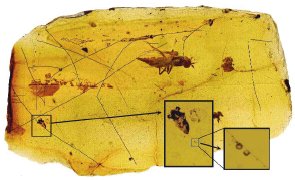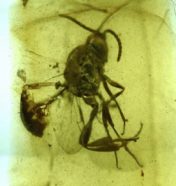An Ancient Spider’s Web
The diets of some spiders haven't changed much in millions of years.
By Emily Sohn
A spider’s silk web is strong enough to snare insects, but usually too delicate to withstand harsh weather and the ravages of time. So, even though spiders have lived on Earth for millions of years, few of their webs have lasted that long.
Now, scientists have uncovered a clue to ancient spider life in a piece of fossilized tree resin (called amber) that is 110 million years old. The Spanish amber contains several strands of an ancient spider web, captured insects included.
 | ||
|
| ||
| © Science |
The team of researchers found pieces of at least 26 strands of silk in the amber. Most of the strands are either straight or slightly curved.
The longest strand is about 5.7 millimeters (0.2 inch) in length. Most strands are between 0.6 and 1.9 micrometers wide. (A micrometer is one-millionth of a meter.) The amber is about 18 millimeters (0.7 inch) long.
In the webs of modern orb-web spiders, long strands of silk connect at a center point, like the spokes of a bicycle wheel. Sticky, insect-catching threads then connect the long spoke strands, forming rings that spiral out from the center.
 |
|
An orb web made by a spider from Palo Alto, Calif.
|
| Photo courtesy of Mark Chappell |
Some of the amber-preserved strands form a similar pattern, which suggests that the ancient spider belonged to the orb-web family. Further supporting this view, the specimen holds two drops of the “glue” that these spiders use to add stickiness to their webs.
 |
|
A wasp trapped in an ancient spider web.
|
| © Science |
It makes sense that the spider’s web-weaving strategy has remained essentially the same for millions of years. After all, it seems to work. Also caught in the amber were a wasp, a fly, and a mite. Orb-web spiders still eagerly devour these insects today.—E. Sohn
Going Deeper:
Perkins, Sid. 2006. Sticky subjects: Insights into ancient spider diet, kinship. Science News 169(June 24):390. Available at http://www.sciencenews.org/articles/20060624/fob7.asp .
LabZone
Spy on a Spider
http://www.sciencenewsforkids.org/articles/20040519/LZActivity.asp
ScienceFairZone
Tobacco Smoke and Spiders
http://www.sciencenewsforkids.org/articles/20040317/ScienceFairZone.asp







